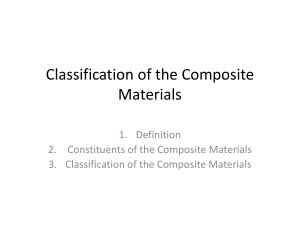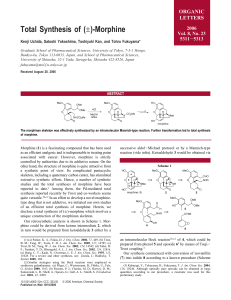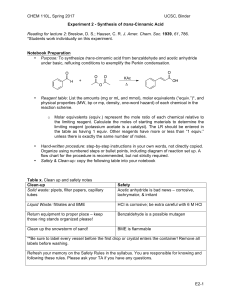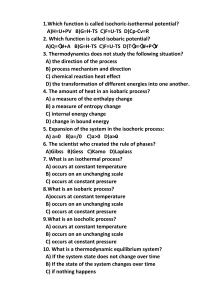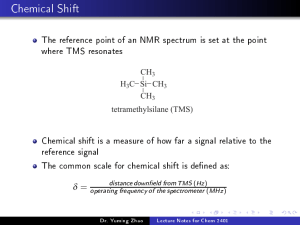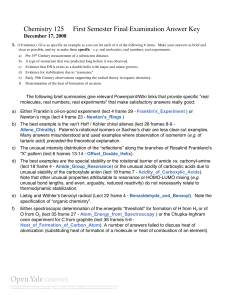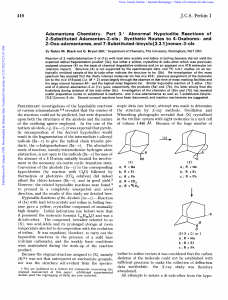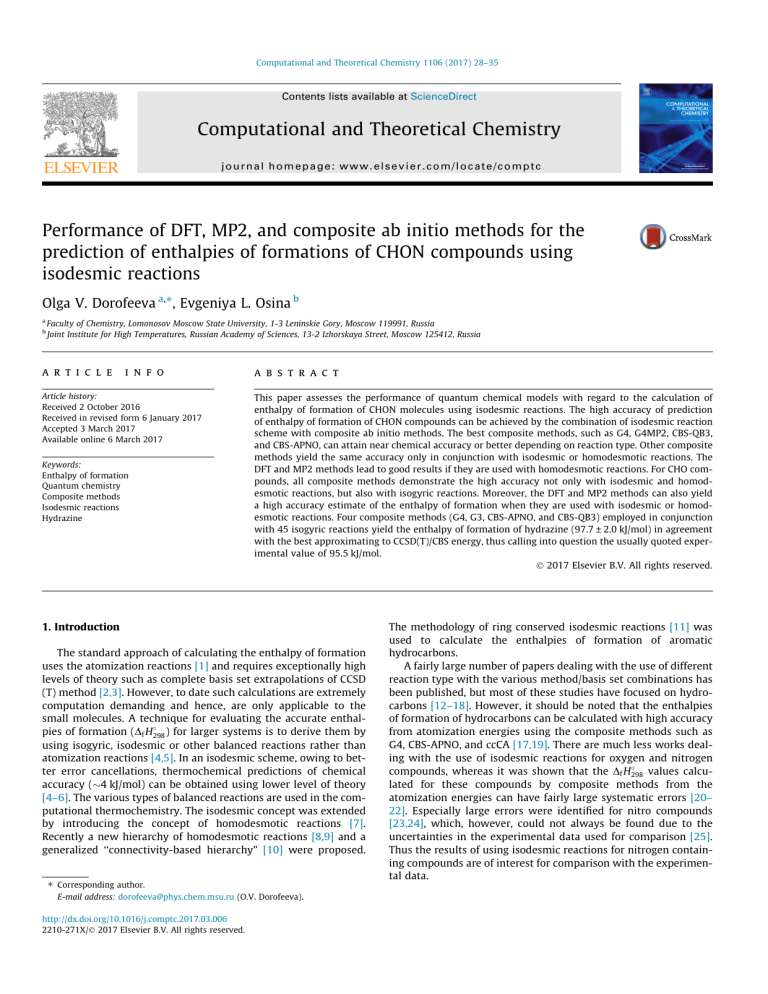
Computational and Theoretical Chemistry 1106 (2017) 28–35 Contents lists available at ScienceDirect Computational and Theoretical Chemistry journal homepage: www.elsevier.com/locate/comptc Performance of DFT, MP2, and composite ab initio methods for the prediction of enthalpies of formations of CHON compounds using isodesmic reactions Olga V. Dorofeeva a,⇑, Evgeniya L. Osina b a b Faculty of Chemistry, Lomonosov Moscow State University, 1-3 Leninskie Gory, Moscow 119991, Russia Joint Institute for High Temperatures, Russian Academy of Sciences, 13-2 Izhorskaya Street, Moscow 125412, Russia a r t i c l e i n f o Article history: Received 2 October 2016 Received in revised form 6 January 2017 Accepted 3 March 2017 Available online 6 March 2017 Keywords: Enthalpy of formation Quantum chemistry Composite methods Isodesmic reactions Hydrazine a b s t r a c t This paper assesses the performance of quantum chemical models with regard to the calculation of enthalpy of formation of CHON molecules using isodesmic reactions. The high accuracy of prediction of enthalpy of formation of CHON compounds can be achieved by the combination of isodesmic reaction scheme with composite ab initio methods. The best composite methods, such as G4, G4MP2, CBS-QB3, and CBS-APNO, can attain near chemical accuracy or better depending on reaction type. Other composite methods yield the same accuracy only in conjunction with isodesmic or homodesmotic reactions. The DFT and MP2 methods lead to good results if they are used with homodesmotic reactions. For CHO compounds, all composite methods demonstrate the high accuracy not only with isodesmic and homodesmotic reactions, but also with isogyric reactions. Moreover, the DFT and MP2 methods can also yield a high accuracy estimate of the enthalpy of formation when they are used with isodesmic or homodesmotic reactions. Four composite methods (G4, G3, CBS-APNO, and CBS-QB3) employed in conjunction with 45 isogyric reactions yield the enthalpy of formation of hydrazine (97.7 ± 2.0 kJ/mol) in agreement with the best approximating to CCSD(T)/CBS energy, thus calling into question the usually quoted experimental value of 95.5 kJ/mol. Ó 2017 Elsevier B.V. All rights reserved. 1. Introduction The standard approach of calculating the enthalpy of formation uses the atomization reactions [1] and requires exceptionally high levels of theory such as complete basis set extrapolations of CCSD (T) method [2,3]. However, to date such calculations are extremely computation demanding and hence, are only applicable to the small molecules. A technique for evaluating the accurate enthalpies of formation (Df H298 ) for larger systems is to derive them by using isogyric, isodesmic or other balanced reactions rather than atomization reactions [4,5]. In an isodesmic scheme, owing to better error cancellations, thermochemical predictions of chemical accuracy (4 kJ/mol) can be obtained using lower level of theory [4–6]. The various types of balanced reactions are used in the computational thermochemistry. The isodesmic concept was extended by introducing the concept of homodesmotic reactions [7]. Recently a new hierarchy of homodesmotic reactions [8,9] and a generalized ‘‘connectivity-based hierarchy” [10] were proposed. ⇑ Corresponding author. E-mail address: dorofeeva@phys.chem.msu.ru (O.V. Dorofeeva). http://dx.doi.org/10.1016/j.comptc.2017.03.006 2210-271X/Ó 2017 Elsevier B.V. All rights reserved. The methodology of ring conserved isodesmic reactions [11] was used to calculate the enthalpies of formation of aromatic hydrocarbons. A fairly large number of papers dealing with the use of different reaction type with the various method/basis set combinations has been published, but most of these studies have focused on hydrocarbons [12–18]. However, it should be noted that the enthalpies of formation of hydrocarbons can be calculated with high accuracy from atomization energies using the composite methods such as G4, CBS-APNO, and ccCA [17,19]. There are much less works dealing with the use of isodesmic reactions for oxygen and nitrogen compounds, whereas it was shown that the Df H298 values calculated for these compounds by composite methods from the atomization energies can have fairly large systematic errors [20– 22]. Especially large errors were identified for nitro compounds [23,24], which, however, could not always be found due to the uncertainties in the experimental data used for comparison [25]. Thus the results of using isodesmic reactions for nitrogen containing compounds are of interest for comparison with the experimental data. O.V. Dorofeeva, E.L. Osina / Computational and Theoretical Chemistry 1106 (2017) 28–35 Although density functional methods combined with isodesmic reaction energies can yield accurate thermochemistry for large molecules [6], Raghavachari et al. [26] have demonstrated that the combination of bond separation reactions with composite G2 method leads to a dramatic improvement in the accuracy of theoretically evaluated enthalpies of formation. The isodesmic reactions in conjunction with composite ab initio methods such as those of the Gaussian-n (Gn) and complete basis set (CBS) varieties have been used extensively by Bozzelli et al. [27–33] to compute accurate enthalpies of formation of aldehydes, ketones, hydroperoxides, nitro and nitrite compounds, nitrocarbonyls, nitroolefins, and others. It has been shown that the use of isodesmic work reactions with composite ab initio methods (CBS-QB3, CBS-APNO, G3, G3MP2B3, G4) can lead to error reductions from around ±4 kJ/mol to ±2 kJ/mol or less. The DFT methods (B3LYP/6-31G(d,p), B3LYP/6-311G(2d,2p), and M06-2X/6-311 +G(2d,d,p)) were also used by Bozzelli et al. in calculating enthalpies of formation [30–33]. In some cases, the authors point out that the results from DFT and ab initio calculations were in excellent agreement [32], whereas more often these methods demonstrate relatively high standard deviations, which were two or more times higher than the composite method calculations. A variety of isodesmic or homodesmotic reactions, where the bonding environments are similar in products and reagents, has been used in the above mentioned works [27–33]. However, such reactions are not always possible to design for larger molecules with complex structure. Moreover, it becomes often impossible to carry out high level composite ab initio calculations for such molecules. For example, to estimate the enthalpy of formation of polycyclic nitramine CL-20, two not well balanced reactions ðCHÞ6 ðNNO2 Þ6 ðCL-20Þ þ 12 CH4 þ 6 NH3 ! 3 CH3 CH3 þ 6 CH3 NHCH3 þ 6 H2 NNO2 ðCHÞ6 ðNNO2 Þ6 ðCL-20Þ þ 24 CH3 NH2 ! 3 CH3 CH3 þ 6 CH3 NðNO2 ÞCH3 þ 12 NH2 CH2 NH2 were used in conjunction with the B3LYP/6-31G(d,p) model [34– 37]. In our later study [38], it was shown that this approach overestimates the enthalpy of formation of CL-20 by 160–200 kJ/mol. Therefore, it is important to know the errors associated with the type of reactions and quantum chemical methods used in calculation of enthalpies of formation of molecules of different size and composition. In the present work, we show that the isodesmic and other error canceling reactions can offer significant benefit and increased accuracy when composite ab initio methods are used to calculate the reaction enthalpies. Our conclusion is based on a large number of calculations for different CHON compounds by composite G4 method applied to both atomization and isodesmic reactions [21–24,38–42]. In these works, it was shown that the G4 method combined with atomization reaction is highly accurate for the prediction of enthalpies of formation CHO compounds [21,42], while its accuracy is decreased for nitrogen containing compounds, especially for nitro compounds [23,24]. In the present work, it will be shown that the atomic composition of the target molecule is also important when the isodesmic reactions are used. To clearly show this, we chose two molecules, CH3ONO2 and CH3OCH3, with reliable experimental Df H298 values and used them to examine the performance of DFT, MP2, and composite ab initio models in the calculation of enthalpies of formation using isodesmic and other balanced reactions. 29 2. Computational details Three DFT functionals (B3LYP, B3PW91, and M06-2X), MP2 method, and seven composite ab initio models (G4, G4MP2, G3, G3MP2B3, G2, CBS-QB3, and CBS-APNO) were assessed for the evaluation of enthalpies of formation of CH3ONO2 and CH3OCH3. Two relatively large basis sets, 6-311+G(3df,2p) and cc-pVTZ, were considered initially to derive the total energies for the different DFT techniques and MP2 method. In terms of mean absolute deviation (MAD) from experiment, the DFT models with 6-311+G (3df,2p) provide more accurate results than the use of cc-pVTZ basis set. Conversely, the MP2 method gives significantly better results with cc-pVTZ basis set. For this reason, only the results obtained at DFT/6-311+G(3df,2p) and MP2/cc-pVTZ levels are given finally in Tables 1 and 2 and discussed further in next section. All quantum chemical calculations were performed using the Gaussian 03 package of programs [43]. Thirteen reactions of different type (isogyric, isodesmic, and homodesmotic) were constructed for each molecule (Tables 1 and 2). These reactions contain radicals, inorganic, and organic reference species. The accurate values of enthalpies of formation recommended in Active Thermochemical Tables (ATcT) [44] were accepted for most reference species, with the exception of ethers (C2H5OC2H5, CH3OC3H7, (CH3)2CHOCH3, and C6H5OCH3), nitrates (CH3CH2ONO2, C3H7ONO2, and (CH3)2CHONO2), and nitro compounds (CH3NO2, C2H5NO2, CH3NHNO2, and CH3N(NO2)CH3). For anisole, the accurate enthalpy of formation determined recently by Simões et al. [45] was used in this work. The Df H298 values for aliphatic ethers and nitrates were taken from the thermochemical archive by Pedley [46]; these values give consistent results for reactions 11–13 (Tables 1 and 2), thus confirming their accuracy. The enthalpies of formation of four nitro compounds are those recommended in Ref. [23]. The resulting enthalpy of formation was calculated combining the calculated enthalpy of reaction with the experimental enthalpies of formation of reference molecules. The scale factors for DFT and MP2 frequencies needed to calculate the zero-point energies and thermal corrections were taken from Ref. [47]. For comparison, the Df H298 values calculated using atomization reaction were also included in Tables 1 and 2. 3. Results and discussion The enthalpies of formation of CH3ONO2 and CH3OCH3 calculated from thirteen work reactions using different quantum chemical models are given in Tables 1 and 2. These tables also include the error statistics for each method: the mean absolute deviation (MAD), the root-mean-square deviation (RMSD), maximum negative and maximum positive deviation from the corresponding experimental value. The value of Df H298 (CH3ONO2, g) = 122.2 ± 1.3 kJ/mol was determined by Ray and Ogg [48] from calorimetric investigation of the gas phase enthalpy of the reaction between N2O5 and CH3ONO to form an equilibrium mixture of NO2 and N2O4 plus CH3ONO2. This value is cited in the NIST Chemistry WebBook [49] and recommended by Pedley [46]. However, this value becomes somewhat more positive when the more recent enthalpies of formation of reaction components are used. The value of 119.4 kJ/mol was obtained in the present work using the enthalpies of formation of nitrogen oxides represented in ATcT [44] and experimental enthalpy of formation of CH3ONO recommended on the basis of quantum chemical calculations [29]. Another value of Df H298 (CH3ONO2, g) = 123.0 ± 3.3 kJ/mol was found by combining the available value of the enthalpy of formation of liquid CH3ONO2 with the enthalpy of vaporization [48]. Thus, the values of 119.4 kJ/mol and 123.0 kJ/mol can be 30 O.V. Dorofeeva, E.L. Osina / Computational and Theoretical Chemistry 1106 (2017) 28–35 Table 1 Gas-phase enthalpy of formation of methyl nitrate calculated from different reactions using different quantum chemical methods (in kJ/mol). a c d B3PW91a Atomization reaction CH3ONO2 ? C(cr) + 1.5 H2(g) + 0.5 N2(g) + 1.5 O2(g) 118.6 126.8 138.1 119.8 131.0 124.2 132.2 141.8 137.3 140.0 161.5 Isogyric reactions 1 CH3ONO2 + CH4 ? CH3OH + CH3NO2 2 CH3ONO2 + CH3CH3 ? CH3OH + CH3CH2NO2 3 CH3ONO2 + NH2OH ? H2O2 + CH3NHNO2 4 CH3ONO2 + CH3NH2 ? CH3N(NO2)CH3 + H2O 5 CH3ONO2 + H2O ? CH3OOH + HNO2(trans) 6 CH3ONO2 + CH3 ? CH3OCH3 + NO2 7 CH3ONO2 + CH3 ? CH3CH3 + NO3 118.0 119.0 122.4 121.9 121.6 118.7 125.1 122.2 122.7 122.8 121.5 126.5 121.3 121.5 119.5 120.2 125.3 122.5 122.7 123.4 132.3 123.9 124.7 122.6 122.9 128.5 117.9 131.0 122.1 122.9 124.3 121.6 128.8 126.6 142.2 128.4 133.2 124.7 137.7 125.4 123.8 115.8 Isodesmic 8 9 10 121.7 121.3 122.8 121.5 121.2 122.2 120.2 120.0 121.7 123.5 123.0 120.2 122.7 122.6 120.1 123.8 118.5 123.2 120.5 122.9 127.1 115.7 122.4 120.1 114.8 118.3 121.3 121.0 118.2 119.7 123.0 111.8 121.1 Homodesmotic reactions 11 CH3ONO2 + CH3CH2CH3 ? CH3CH2ONO2 + CH3CH3 120.4 119.9 119.1 12 CH3ONO2 + C3H7CH3 ? C3H7ONO2 + CH3CH3 120.2 119.7 118.5 13 CH3ONO2 + (CH3)3CH ? (CH3)2CHONO2 + CH3CH3 119.9 118.6 117.0 119.6 119.0 118.0 119.7 119.2 117.2 118.8 119.2 117.9 119.5 115.7 119.0 119.6 119.3 120.5 119.9 119.1 118.7 119.9 119.4 118.0 116.6 119.2 118.8 122.2 2.7 3.7 11.1 3.2 122.5 3.2 4.1 9.8 4.0 123.9 4.4 6.8 21.0 5.5 123.0 5.3 8.6 16.5 5.5 reactions CH3ONO2 + H2O ? CH3OH + HONO2 CH3ONO2 + H2O2 ? CH3OOH + HONO2 2 CH3ONO2 ? CH3OCH3 + O2NONO2 Average of all reactions MADc RMSd Maximum negative deviation Maximum positive deviation b MP2b G4MP2 G4 120.8 1.5 1.8 3.9 3.2 120.1 120.8 122.5 123.0 125.2 123.0 125.7 121.6 1.7 2.1 4.5 2.6 CBS-QB3 G3MP2B3 CBS-APNO G3 M06-2Xa B3LYPa G2 Reaction 121.5 1.7 2.3 5.3 4.2 121.0 122.7 123.4 121.7 127.6 125.4 158.5 124.9 5.2 6.8 37.3 2.7 120.4 141.1 125.7 123.6 126.4 124.2 144.5 125.2 5.5 8.9 23.3 4.6 127.2 127.0 123.7 120.2 147.5 135.0 110.2 123.3 6.2 9.5 26.3 11.0 128.3 135.3 124.1 134.3 139.8 128.7 112.5 124.3 6.7 10.8 18.6 8.7 6-311+G(3df,2p) basis set. cc-pVTZ basis set. Mean absolute deviation. Root-mean-square deviation. Table 2 Gas-phase enthalpy of formation of dimethyl ether calculated from different reactions using different quantum chemical methods (in kJ/mol). Atomization reaction CH3OCH3 ? 2 C(cr) + 3 H2(g) + 0.5 O2(g) 184.8 183.3 182.4 189.4 185.5 191.7 192.2 142.1 196.0 189.8 184.5 Isogyric reactions 1 CH3OCH3 + CH4 ? CH3OH + CH3CH3 2 CH3OCH3 ? CH3CH2OH 3 CH3OCH3 + C6H6 ? C6H5CH3 + CH3OH 4 CH3OCH3 + H2O ? CH3OOH + CH4 5 CH3OCH3 + H2O2 ? HOCH2CH2OH + H2O 6 CH3OCH3 + OH ? CH3OH + CH3 O 7 CH3OCH3 + OH ? CH3OOH + CH3 185.2 186.4 184.1 183.7 184.4 181.7 185.1 183.7 185.3 183.3 185.9 182.6 181.8 187.3 185.2 185.5 184.6 184.8 181.7 186.2 185.7 187.4 188.3 186.0 184.7 183.3 184.2 186.9 189.3 192.1 192.8 190.1 185.1 179.1 192.9 184.7 188.6 190.0 177.7 195.2 165.7 180.9 188.6 192.2 195.2 173.8 202.0 166.2 179.6 Isodesmic 8 9 10 182.5 183.8 182.3 183.3 185.1 183.6 183.1 184.0 182.9 183.3 186.0 184.4 183.2 188.4 182.7 183.5 181.4 181.8 181.6 184.1 180.8 180.5 185.1 182.8 183.5 181.9 180.7 177.3 180.7 181.0 177.4 180.1 182.8 Homodesmotic reactions 11 CH3OCH3 + C2H5C2H5 ? C2H5OC2H5 + CH3CH3 184.0 183.6 12 CH3OCH3 + C2H5C2H5 ? CH3OC3H7 + CH3CH3 182.8 182.4 13 CH3OCH3 + (CH3)3CH ? (CH3)2CHOCH3 + CH3CH3 183.2 182.8 184.8 183.0 183.3 181.9 184.0 182.2 182.5 183.1 181.7 182.4 181.2 182.1 184.4 183.4 185.4 182.8 181.4 181.7 182.7 183.0 184.2 183.5 183.4 183.6 182.7 183.0 183.0 184.1 1.3 1.5 3.3 2.2 183.6 1.7 1.8 2.2 2.8 184.3 1.8 2.2 4.3 3.5 182.5 5.0 7.0 11.2 18.3 183.6 6.9 8.9 18.0 17.8 Average of all reactions MADc RMSDd Maximum negative deviation Maximum positive deviation a b c d 183.9 1.1 1.3 2.4 2.3 183.9 184.9 184.5 186.4 180.8 185.1 187.3 184.0 1.2 1.6 3.3 3.2 187.1 188.2 187.2 183.4 186.6 182.7 184.3 184.5 1.6 2.1 4.2 2.1 CBS-APNO G2 M06-2Xb B3PW91b B3LYPb G4 reactions CH3OCH3 + H2O ? 2 CH3OH CH3OCH3 + H2O2 ? CH3OOH + CH3OH CH3OCH3 + C6H5CH3 ? C6H5OCH3 + CH3CH3 G3MP2B3 G4MP2 CBS-QB3 G3 MP2a Reaction 185.0 186.1 185.2 184.4 179.9 183.7 186.3 184.0 1.8 2.2 4.4 4.1 183.3 183.3 181.6 189.2 176.7 193.6 181.4 183.7 2.8 3.9 9.6 7.3 185.9 4.2 5.1 8.9 4.9 cc-pVTZ basis set. 6-311+G(3df,2p) basis set. Mean absolute deviation. Root-mean-square deviation. considered as the upper and lower limits for the enthalpy of formation of CH3ONO2. The average of these two values 121.2 ± 2.0 kJ/mol is accepted in this work for the enthalpy of formation of CH3ONO2. For CH3OCH3, the gas-phase enthalpy formation (184.0 ± 0.4 kJ/mol) recommended in ATcT [44] is used in this work. The average values determined by each method are com- pared with experimental ones in Figs. 1 and 2. These figures also show the scatter of the calculated Df H298 values about their average. A comparison of Tables 1 and 2 and Figs. 1 and 2 (for clarity, the figures are shown at the same scale) reveals that, in general, the accuracy of calculated values for CH3ONO2, is substantially lower 31 O.V. Dorofeeva, E.L. Osina / Computational and Theoretical Chemistry 1106 (2017) 28–35 -110 -115 CBS-QB3 G4MP2 G2 CBS-APNO M06-2X -120 -125 G4 -130 G3MP2B3 -135 -140 B3LYP B3PW91 G3 -145 -150 MP2 -155 CH3ONO2 -160 Fig. 1. Comparison of the performance of different methods used in isodesmic reaction calculations of enthalpy of formation of CH3ONO2. The dashed lines represent the upper and lower limits for the available experimental values. The red and black circles are the average values obtained by each method. The vertical lines with caps show the range between the maximum and minimum values obtained for reactions 1–13 (Table 1). The methods are arranged in ascending order of the MAD; the methods with MAD and RMSD values less than 3 kJ/mol are marked in red color. (For interpretation of the references to colour in this figure legend, the reader is referred to the web version of this article.) ° , -155 -160 B3LYP -165 -170 MP2 -175 -180 G2 G3 G4MP2 G4 M06-2X -185 -190 G3MP2B3 CBS-QB3 CBS-APNO -195 B3PW91 -200 CH3OCH3 -205 Fig. 2. Comparison of the performance of different methods used in isodesmic reaction calculations of enthalpy of formation of CH3OCH3. The dashed lines represent the uncertainty of experimental value. The red and black circles are the average values obtained by each method. The vertical lines with caps show the range between the maximum and minimum values obtained for reactions 1–13 (Table 2). The methods are arranged in ascending order of the MAD; the methods with MAD and RMSD values less than 3 kJ/mol are marked in red color. (For interpretation of the references to colour in this figure legend, the reader is referred to the web version of this article.) than that for CH3OCH3. For CH3ONO2, only three composite methods, G4MP2, G4, and CBS-QB3, are found to have MAD and RMSD less than 3 kJ/mol, while all seven composite methods lead to almost the same result for CH3OCH3: the MAD and RMSD do not exceed 1.8 and 2.2 kJ/mol, respectively (Table 2). Concerning the MP2 and DFT methods, they all have large error for both molecules. At the same time, we can see that the average values calculated by each method reproduce relatively well the experimental enthalpy of formation: the deviations do not exceed 4 kJ/mol for CH3ONO2 and 1.5 kJ/mol for CH3OCH3. Thus, even the methods with a large spread of values around the average (these methods are marked in black in Figs. 1 and 2) can give reasonable estimations if a 32 O.V. Dorofeeva, E.L. Osina / Computational and Theoretical Chemistry 1106 (2017) 28–35 40 35 CH3ONO2 30 25 20 isogyric isodesmic homodesmoc 15 10 5 0 Fig. 3. The differences between the maximum and minimum enthalpies of formation of CH3ONO2 calculated using different types of work reactions (isogyric, isodesmic, and homodesmotic) and different quantum chemical methods. 40 CH3OCH3 35 30 25 20 isogyric isodesmic homodesmoc 15 10 5 0 Fig. 4. The differences between the maximum and minimum enthalpies of formation of CH3OCH3 calculated using different types of work reactions (isogyric, isodesmic, and homodesmotic) and different quantum chemical methods. sufficient large number of reactions is used. However, in practice much less reactions are actually used; for complex molecules, the prediction of enthalpy of formation is often based on a single reaction. Therefore, it is important to know how the accuracy of calculation varies when different work reactions are used. To have a better understanding of this issue, we analyzed the spread of the calculated Df H298 values depending on the type of work reactions and method used (Figs. 3 and 4). The isogyric reactions, as expected, have the largest differences between the maximum and minimum values for all methods. However, it should be noted that these differences are not so important for methods with low values of MAD and RMSD (methods marked by red in Figs. 1 and 2). In other words, even isogyric reactions give reasonable agreement with the experimental values, when the composite G4MP2, G4, and CBS-QB3 methods are used for CH3ONO2 and when any of the composite methods are used for CH3OCH3. Compared to isogyric reactions, isodesmic and homodesmotic reactions result in a much smaller spread of the calculated values. The isodesmic and homodesmotic reactions show almost the same good results for CH3ONO2, when they are used in combination with any of the composite models (Fig. 3). As concerns DFT and MP2 methods, they give much more reliable results with homodesmotic reactions, while the isodesmic reactions result in less accurate predictions. On the other hand, as follows from Fig. 4, in general, the O.V. Dorofeeva, E.L. Osina / Computational and Theoretical Chemistry 1106 (2017) 28–35 33 115 B3LYP M06-2X MP2 110 G2 G4MP2 105 G3 CBS-QB3 G4 100 95 W3X-L exp 90 CBS-APNO G3MP2B3 85 80 B3PW91 H2NNH2 75 Fig. 5. Comparison of the performance of different methods used in isogyric reaction calculations of enthalpy of formation of H2NNH2. The dashed lines correspond to the experimental value of 95.55 kJ/mol [44] (blue line) and to the W3X-L value of 97.5 kJ/mol [3] (green line). The red and black circles are the average values obtained by each method. The vertical lines with caps show the range between the maximum and minimum values obtained for 45 reactions (Table S1). The methods are arranged in ascending order of the MAD; the methods with MAD and RMSD values less than 2 kJ/mol are marked in red color. (For interpretation of the references to colour in this figure legend, the reader is referred to the web version of this article.) close Df H298 values are estimated for CH3OCH3 using all methods (composite, DFT, or MP2) in conjunction with isodesmic or homodesmotic reactions. Moreover, some composite methods (G4, G4MP2, G3, and G3MP2B3) reproduce well the experimental enthalpy of formation even when the atomization reaction is used (Table 2). Therefore, we can conclude that the accuracy of calculated values depends on the atomic composition of the molecule and it is lower for CHON compounds than for CHO. A large difference between the results for CHON and CHO compounds is observed not for all nitrogen containing compounds. A smaller effect is observed, for example, for amines. However, this effect increases with the increasing number of amino groups, while it decreases with the presence, for example, of AC@O group [22,41]. The purpose of this work is to draw attention to the need for more careful selection of work reactions and the method of calculation for nitrogen containing compounds. The Df H298 values of some nitroalkanes and alkyl nitrites were calculated by Snitsiriwat et al. [30] at B3LYP/6-31G(d,p), B3LYP/6-31 + G(2d,2p), and the composite CBS-QB3 levels using three work reactions for each species. Although the authors note that the values computed by CBS-QB3 method are close to the experimental data, the B3LYP calculations also reproduce the experimental values reasonably well. This result is due to homodesmotic and isodesmic reactions used in Ref. [30], and it is in excellent agreement with the results obtained in the present work for CBS-QB3 and B3LYP models (Fig. 3). Unfortunately, the isodesmic and especially homodesmotic reactions cannot always be used because of a lack of reference species with accurately known enthalpies of formation. Besides, it is often impossible to construct the isodesmic reactions for some species. One such molecule, hydrazine, we would like to discuss in more detail. The value of Df H298 (H2NNH2, g) = 95.55 kJ/mol is recommended in ATcT [44] based on the available experimental data; the close value (95.35 kJ/mol) is presented at NIST Chemistry Webbook [49]. However, this value disagrees with the values calculated by composite methods (100.8 ± 2.0 kJ/mol, average of CBS-QB3, CBS- APNO, G3, and G4 methods [20]; 98.3–101.7 kJ/mol, ccCA-P with different basis sets [50]) and by accurate approximation to the CCSD(T)/CBS energy (96.7 kJ/mol [51] and 97.5 kJ/mol, W3X-L [3]). We have tried to estimate the enthalpy of formation of hydrazine using the combination of isogyric reactions with the different methods, as it was done earlier for CH3ONO2 and CH3OCH3 (the isodesmic reactions with hydrazine derivatives were not considered because of uncertainty in their experimental values). Among the 45 reactions used there are 15 reactions with radicals, 15 reactions with small reference species and reliable experimental enthalpies of formation from ATcT, and 15 reactions with larger species not represented in ATcT (Table S1 of Supplementary material). The average values determined by each method are compared with the experimental value and the most accurate calculated W3X-L value in Fig. 5; this figure also shows the scatter of the calculated Df H298 values about their averages. It can be seen that the results for H2NNH2 are similar to the picture observed for CH3 ONO2 (Fig. 1). Four composite methods, G3, G4, CBS-APNO, and CBS-QBS, result in the lowest scatter of calculated values and in very close average Df H298 values. Note that the average values for three groups of isogyric reactions (Table S1 of Supplementary material) are also in close agreement. The average value of four composite methods, 97.7 kJ/mol, is in excellent agreement with the W3X-L value of 97.5 kJ/mol [3]. Thus, the issue of difference between the experimental and calculated values of enthalpy of formation of hydrazine remains open for further studies. 4. Conclusions The method of isodesmic reactions utilizes a similarity in the bonding environments for reactants and products in a work reaction and leads to a cancellation of systematic errors in the ab initio or DFT calculations. The enthalpies of formation of CHO compounds can be estimated with chemical accuracy (errors < 4 kJ/ mol) using the isodesmic or homodesmotic reactions in 34 O.V. Dorofeeva, E.L. Osina / Computational and Theoretical Chemistry 1106 (2017) 28–35 conjunction with DFT, MP2, and composite ab initio methods. The composite methods can often provide the chemical accuracy even with isogyric reactions. A near subchemical accuracy (1 kJ/mol and better) for CHO compounds can be achieved using the best composite methods (G4, G4MP2, CBS-QB3, and CBS-APNO) with homodesmotic reactions. An additional example in support of this statement is the calculation of enthalpy of formation of phenol by G4 method using 36 work reactions of different types [42]. The following values of MAD, RMSD, and difference between the maximum and minimum values were obtained for 36 reactions, respectively: 1.0, 1.2, and 3.9 kJ/mol. For CHON compounds and especially for nitro compounds, DFT (B3LYP, B3PW91, and M06-2X) and MP2 methods lead to a large error when they are used in combination with isogyric or isodesmic reactions. Thus, it is desirable to avoid the use of DFT and MP2 methods in isodesmic reaction calculations if it is impossible to construct the homodesmotic reactions. The composite methods demonstrate the higher accuracy comparing with the DFT and MP2. The best composite methods, such as G4, CBS-QB3, and CBS-APNO, yield chemical accuracy or better depending on reaction type. Because of this, the isodesmic reactions will continue to be a useful tool for calculating the gas-phase enthalpies of formation, although the application of accurate correlated computational methods becomes feasible now for modestly sized molecules. [13] [14] [15] [16] [17] [18] [19] [20] [21] [22] [23] Acknowledgments [24] This research was supported by the Russian Foundation for Basic Research under Grant No. 14-03-00612. [25] Appendix A. Supplementary material Supplementary data associated with this article can be found, in the online version, at http://dx.doi.org/10.1016/j.comptc.2017.03. 006. These data include the enthalpy of formation of hydrazine calculated from different work reactions using different quantum chemical methods. [26] [27] [28] [29] References [30] [1] L.A. Curtiss, K. Raghavachari, P.C. Redfern, J.A. Pople, Assessment of Gaussian-2 and density functional theories for the computation of enthalpies of formation, J. Chem. Phys. 106 (1997) 1063–1079. [2] D. Feller, K.A. Peterson, An expanded calibration study of the explicitly correlated CCSD(T)-F12b method using large basis set standard CCSD(T) atomization energies, J. Chem. Phys. 139 (2013) 084110. [3] B. Chan, L. Radom, W2X and W3X-L: cost-effective approximations to W2 and W4 with kJ mol1 accuracy, J. Chem. Theory Comput. 11 (2015) 2109–2119. [4] W.J. Hehre, R. Ditchfield, L. Radom, J.A. Pople, Molecular orbital theory of the electronic structure of organic compounds. V. Molecular theory of bond separation, J. Am. Chem. Soc. 92 (1970) 4796–4801. [5] W.J. Hehre, L. Radom, P.v.R. Schleyer, J.A. Pople, Ab Initio Molecular Orbital Theory, Wiley, New York, 1986. [6] K. Raghavachari, B.B. Stefanov, L.A. Curtiss, Accurate density functional thermochemistry for larger molecules, Mol. Phys. 91 (1997) 555–559. [7] P. George, M. Trachtman, C.W. Bock, A.M. Brett, An alternative approach to the problem of assessing stabilization energies in cyclic conjugated hydrocarbons, Theor. Chem. Acc. 38 (1975) 121–129. [8] S.E. Wheeler, K.N. Houk, P.v.R. Schleyer, W.D. Allen, A hierarchy of homodesmotic reactions for thermochemistry, J. Am. Chem. Soc. 131 (2009) 2547–2560. [9] S.E. Wheeler, Homodesmotic reactions for thermochemistry, WIREs Comput. Mol. Sci. 2 (2012) 204–220. [10] R.O. Ramabhadran, K. Raghavachari, Theoretical thermochemistry for organic molecules: development of the generalized connectivity-based hierarchy, J. Chem. Theory Comput. 7 (2011) 2094–2103. [11] R. Sivaramakrishnan, R.S. Tranter, K. Brezinsky, Ring conserved isodesmic reactions: a new method for estimating the heats of formation of aromatics and PAHs, J. Phys. Chem. A 109 (2005) 1621–1628. [12] P. George, M. Trachtman, A.M. Brett, C.W. Bock, Comparison of various isodesmic and homodesmotic reaction heats with values derived from [31] [32] [33] [34] [35] [36] [37] [38] [39] [40] published ab initio molecular orbital calculations, J. Chem. Soc., Perkin Trans. 2 (1977) 1036–1047. M.N. Glukhovtsev, S. Laiter, High level ab initio stabilization energies of benzene, Theor. Chim. Acta 92 (1995) 327–332. A. Nicolaides, L. Radom, An evaluation of the performance of G2, G2(MP2) and GZ(MP2, SVP) theories for heats of formation and heats of reaction in the case of ‘large’ hydrocarbons, Mol. Phys. 88 (1996) 759–765. K.B. Wiberg, J.W. Ochterski, Comparison of different ab initio theoretical models for calculating isodesmic reaction energies for small ring and related compounds, J. Comput. Chem. 18 (1997) 108–114. R. Notario, O. Castaño, J.-L.M. Abboud, R. Gomperts, L.M. Frutos, R. Palmeiro, Organic thermochemistry at high ab initio levels. 1. A G2(MP2) and G2 study of cyclic saturated and unsaturated hydrocarbons (including aromatics), J. Org. Chem. 64 (1999) 9011–9014. B.R. Wilson, N.J. DeYonker, A.K. Wilson, Prediction of hydrocarbon enthalpies of formation by various thermochemical schemes, J. Comput. Chem. 33 (2012) 2032–2042. M.D. Wodrich, C. Corminboeuf, S.E. Wheeler, Accurate thermochemistry of hydrocarbon radicals via an extended generalized bond separation reaction scheme, J. Phys. Chem. A 116 (2012) 3436–3447. A. Karton, P.R. Schreiner, J.M.L. Martin, Heats of formation of platonic hydrocarbon cages by means of high-level thermochemical procedures, J. Comput. Chem. 37 (2016) 49–58. J.M. Simmie, A database of formation enthalpies of nitrogen species by compound methods (CBS-QB3, CBS-APNO, G3, G4), J. Phys. Chem. A 119 (2015) 10511–10526. O.V. Dorofeeva, I.N. Kolesnikova, I.I. Marochkin, O.N. Ryzhova, Assessment of Gaussian-4 theory for the computation of enthalpies of formation of large organic molecules, Struct. Chem. 22 (2011) 1303–1314. O.V. Dorofeeva, O.N. Ryzhova, V.P. Sinditskii, Enthalpy of formation of guanidine and its amino and nitro derivatives, Struct. Chem. 26 (2015) 1629–1640. M.A. Suntsova, O.V. Dorofeeva, Use of G4 theory for assessment of inaccuracies in experimental enthalpies of formation of aliphatic nitro compounds and nitramines, J. Chem. Eng. Data 59 (2014) 2813–2826. M.A. Suntsova, O.V. Dorofeeva, Use of G4 theory for assessment of inaccuracies in experimental enthalpies of formation of aromatic nitro compounds, J. Chem. Eng. Data 61 (2016) 313–329. K.R. Jorgensen, G.A. Oyedepo, A.K. Wilson, Highly energetic nitrogen species: reliable energetics via the correlation consistent Composite Approach (ccCA), J. Hazard. Mater. 186 (2011) 583–589. K. Raghavachari, B.B. Stefanov, L.A. Curtiss, Accurate thermochemistry for larger molecules: Gaussian-2 theory with bond separation energies, J. Chem. Phys. 106 (1997) 6764–6767. G. da Silva, J.W. Bozzelli, N. Sebbar, H. Bockhorn, Thermodynamic and ab initio analysis of the controversial enthalpy of formation of formaldehyde, ChemPhysChem 7 (2006) 1119–1126. G. da Silva, J.W. Bozzelli, Enthalpies of formation, bond dissociation energies, and molecular structures of the n-aldehydes (acetaldehyde, propanal, butanal, pentanal, hexanal, and heptanal) and their radicals, J. Phys. Chem. A 110 (2006) 13058–13067. R. Asatryan, J.W. Bozzelli, J.M. Simmie, Thermochemistry of methyl and ethyl nitro, RNO2, and nitrite, RONO, organic compounds, J. Phys. Chem. A 112 (2008) 3172–3185. S. Snitsiriwat, R. Asatryan, J.W. Bozzelli, Thermochemical properties for npropyl, iso-propyl, and tert-butyl nitroalkanes, alkyl nitrites, and their carboncentered radicals, Int. J. Chem. Kinet. 42 (2010) 181–199. S. Snitsiriwat, R. Asatryan, J.W. Bozzelli, Structures, internal rotor potentials, and thermochemical properties for a series of nitrocarbonyls, nitroolefins, corresponding nitrites, and their carbon centered radicals, J. Phys. Chem. A 115 (2011) 13921–13930. J.M. Hudzik, J.W. Bozzelli, Thermochemistry and bond dissociation energies of ketones, J. Phys. Chem. A 116 (2012) 5707–5722. H. Wang, J.W. Bozzelli, Thermochemical properties (DfH°(298 K), S°(298 K), Cp (T)) and bond dissociation energies for C1–C4 normal hydroperoxides and peroxy radicals, J. Chem. Eng. Data 61 (2016) 1836–1849. V.D. Ghule, P.M. Jadhav, R.S. Patil, S. Radhakrishnan, T. Soman, Quantum-chemical studies on hexaazaisowurtzitanes, J. Phys. Chem. A 114 (2010) 498–503. Y. Pan, W. Zhu, H. Xiao, Comparative theoretical studies of dinitromethyl- or trinitromethyl-modified derivatives of CL-20, Can. J. Chem. 91 (2013) 1243– 1251. Y. Wang, C. Qi, J.-W. Song, X.-Q. Zhao, C.-H. Sun, S.-P. Pang, Trinitromethyl/ trinitroethyl substituted CL-20 derivatives: structurally interesting and remarkably high energy, J. Mol. Model. 19 (2013) 1079–1087. J. Zhang, H. Du, F. Wang, X. Gong, S. Ying, Crystal structure, detonation performance, and thermal stability of a new polynitro cage compound: 2, 4, 6, 8, 10, 12, 13, 14, 15-nonanitro-2, 4, 6, 8, 10, 12, 13, 14, 15-nonaazaheptacyclo [5.5.1.13, 11. 15, 9] pentadecane, J. Mol. Model. 18 (2012) 2369–2376. O.V. Dorofeeva, M.A. Suntsova, Enthalpy of formation of CL-20, Comput. Theor. Chem. 1057 (2015) 54–59. I.I. Marochkin, O.V. Dorofeeva, Amide bond dissociation enthalpies: effect of substitution on N-C bond strength, Comput. Theor. Chem. 991 (2012) 182– 191. O.V. Dorofeeva, O.N. Ryzhova, M.A. Suntsova, Accurate prediction of enthalpies of formation of organic azides by combining G4 theory calculations with an isodesmic reaction scheme, J. Phys. Chem. A 117 (2013) 6835–6845. O.V. Dorofeeva, E.L. Osina / Computational and Theoretical Chemistry 1106 (2017) 28–35 [41] O.V. Dorofeeva, O.N. Ryzhova, Gas-phase enthalpies of formation and enthalpies of sublimation of amino acids based on isodesmic reaction calculations, J. Phys. Chem. A 118 (2014) 3490–3502. [42] O.V. Dorofeeva, O.N. Ryzhova, Enthalpy of formation and OH bond dissociation enthalpy of phenol: inconsistency between theory and experiment, J. Phys. Chem. A 120 (2016) 2471–2479. [43] M.J. Frisch, G.W. Trucks, H.B. Schlegel, G.E. Scuseria, M.A. Robb, J.R. Cheeseman, J.A. Montgomery Jr., T. Vreven, K.N. Kudin, J.C. Burant, et al., Gaussian 03, Revision D.01, Gaussian Inc, Wallingford, CT, USA, 2004. [44] B. Ruscic, Updated Active Thermochemical Tables (ATcT) values based on ver. 1.118 of the Thermochemical Network. <http://atct.anl.gov> (Last update October 29, 2015). [45] R.G. Simões, F. Agapito, H.P. Diogo, M.E. Minas da Piedade, Enthalpy of formation of anisole: implications for the controversy on the O-H bond dissociation enthalpy in phenol, J. Phys. Chem. A 118 (2014) 11026–11032. [46] J.B. Pedley, Thermochemical Data and Structures of Organic Compounds, TRC Data Series, College Station, Texas, 1994. 35 [47] NIST Computational Chemistry Comparison and Benchmark Database. NIST Standard Reference Database Number 101, Release 17b, Editor: R.D. Johnson III. <http://cccbdb.nist.gov> (Accessed 01 Aug 2016). [48] J.D. Ray, R.A. Ogg Jr, The heat of formation of methyl nitrate, J. Phys. Chem. 63 (1959) 1522–1523. [49] NIST Chemistry WebBook, NIST Standard Reference Database Number 69; P.J. Linstrom, W.G. Mallard (Eds.), National Institute of Standards and Technology: Gaithersburg MD. <http://webbook.nist.gov> (Accessed Aug 2016). [50] N.J. DeYonker, T. Grimes, S. Yockel, A. Dinescu, B. Mintz, T.R. Cundari, A.K. Wilson, The correlation-consistent composite approach: application to the G3/ 99 test set, J. Chem. Phys. 125 (2006) 104111. [51] M.H. Matus, A.J. Arduengo III, D.A. Dixon, The heats of formation of diazene, hydrazine, N2H+3, N2H+5, N2H, and N2H3 and the methyl derivatives CH3NNH, CH3NNCH3, and CH3HNNHCH3, J. Phys. Chem. A 110 (2006) 10116–10121.
